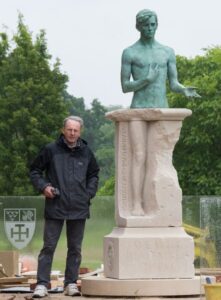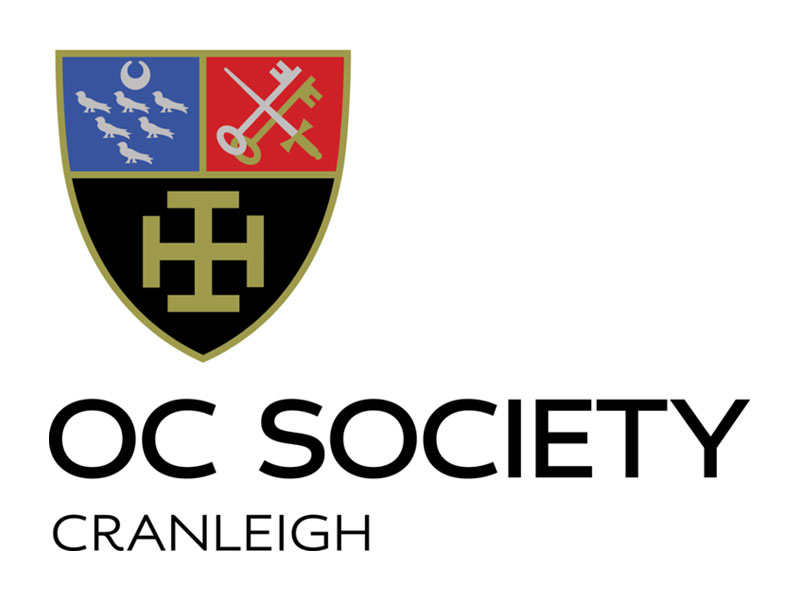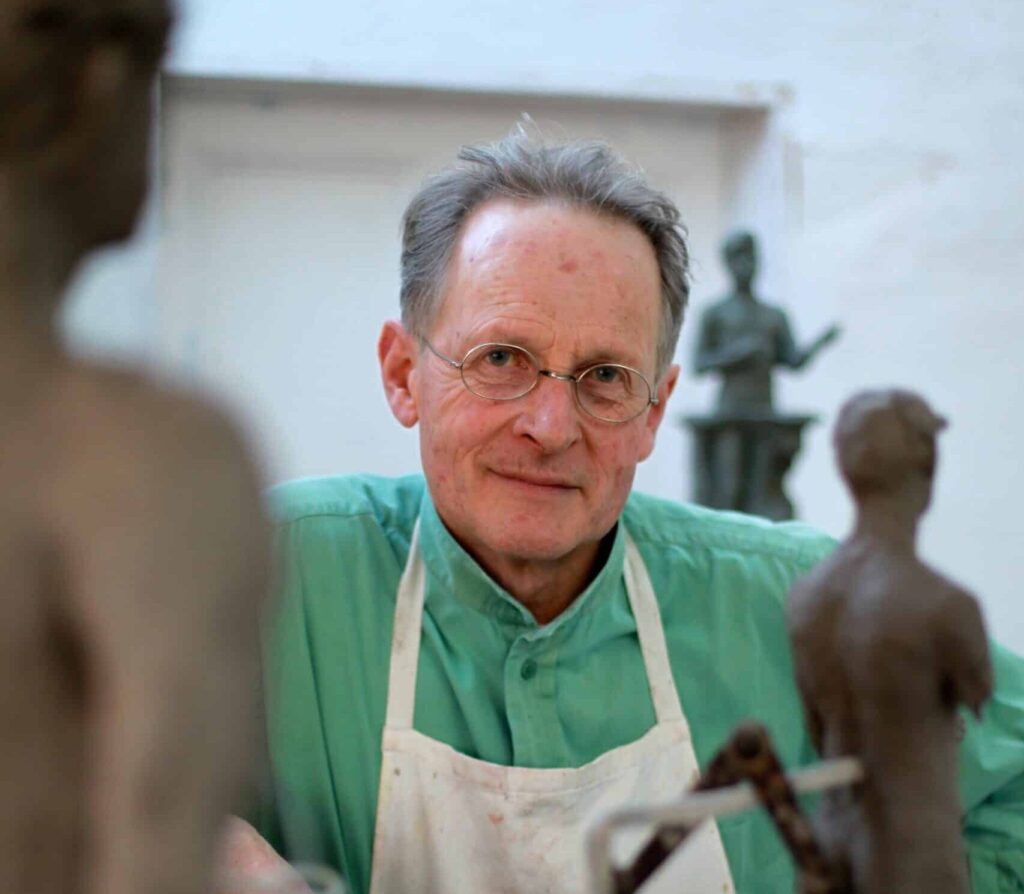Nicholas Dimbleby (2 North 1965), the gifted figurative sculptor who eschewed his father and brothers’ world of broadcasting to follow his own path, died on February 10th aged 77.
In 2016, more than five decades after he left the School, Nicholas returned for the unveiling of ‘Leaving’, hi stunning memorial which stands in front of the Chapel. It was described by the Good Schools Guide as “the most moving war memorial ever seen in a school”.
Nicholas worked with pupils to fine tune the design, and with the School’s architects to create a foundation for his sculpture that carries all the names of the fallen and creates a congregational space. The sculpture itself, made in bronze and stone carving, he said was intended to ‘convey leaving, vulnerability, service to the outside world, and the futility of war.’
His obituary in The Times is reprinted below:-
When Nicholas Dimbleby started as a sculptor he considered adopting a lesser-known surname. He attempted an anagram, but then thought that a literal translation into Chinese with a combination of “dim” as in twilight, “bull” suggesting strength, and “bee” as in flight might make a pleasingly euphonious oriental pseudonym.
 Nicholas was the Dimbleby brother who did not follow father Richard into broadcasting. Instead, he chose a path of figurative sculpture, creating bronzes such as James McNeill Whistler that stands on Cheyne Walk by Battersea Bridge in central London, a life-size figure of Samuel Taylor Coleridge in St Mary’s Churchyard in Ottery St Mary, Devon, and a 2m statue of Jimmy Hill for Coventry City FC. Sir Steve Redgrave, the Olympic rower, once found himself covered in a thick seaweed mixture, the first stage of making a life-size bronze cast. Another commission was from the Royal College of Physicians, to honour doctors who died during the Covid pandemic. Two of Dimbleby’s sculptures were acquired by the King.
Nicholas was the Dimbleby brother who did not follow father Richard into broadcasting. Instead, he chose a path of figurative sculpture, creating bronzes such as James McNeill Whistler that stands on Cheyne Walk by Battersea Bridge in central London, a life-size figure of Samuel Taylor Coleridge in St Mary’s Churchyard in Ottery St Mary, Devon, and a 2m statue of Jimmy Hill for Coventry City FC. Sir Steve Redgrave, the Olympic rower, once found himself covered in a thick seaweed mixture, the first stage of making a life-size bronze cast. Another commission was from the Royal College of Physicians, to honour doctors who died during the Covid pandemic. Two of Dimbleby’s sculptures were acquired by the King.
The aim was to create something greater than a simple portrait. “The sculpture must be more than the sum of its many parts and many processes of creation. At best there is my Pygmalion moment when the work almost comes alive,” he explained.
His statuary can be found in public squares and private gardens across the country, including Captain Cook as a youth in Great Ayton, North Yorkshire, and the Elephant Seat in Jephson Gardens, Leamington Spa. There is also a 12in statuette of the poet Sylvia Plath at Smith College library in Massachusetts, where she was once a student. However, a bronze depicting Duke Ellington standing at a grand piano clicking his fingers and intended for Cambridge Circus, central London, was blocked by planning objections and later disappeared.
Dimbleby also helped to keep alive the art of traditional firebacks. Growing up in West Sussex, he had been fascinated by the collection of 18th-century firebacks at Petworth House. Many years later a neighbour was restoring a hunting lodge in Scotland and asked for one based on the owner’s coat of arms. “At first I was doubtful. I thought the brief was very constrained and would give me no room for expression, but I was quickly humbled by the challenges of such detailed modelling,” he told Country Life.
While his designs remained true to the spirit of early firebacks, which drew heavily on allegory and nature, he increasingly developed a gently whimsical style, including a pair depicting musical animals for the pianist Alfred Brendel. “I’ve done a giant grasshopper for a house in Provence, and a pair of elephants for the Stratfield Saye estate — the 2nd Duke of Wellington had his lawnmower pulled by one when he lived there,” he said.
Yet Dimbleby remained his own harshest critic. “It’s nice to have sculpture, and people can go [to see it],” he said last year. “But when you make a sculpture, I put it out there, and it’s gone from me. When I go and see a piece I’ve done, all I ever see is the mistakes.”
Nicholas Dimbleby was born in 1946, one of four children of Richard Dimbleby and his wife, Dilys (née Thomas): in 1990 he created a bronze relief of his father for Westminster Abbey. He grew up with his older brothers, David and Jonathan, and younger sister, Sally. His own features bore the unmistakable Dimbleby look: broad forehead, well-set blue eyes and a determined jaw.
As children the brothers were close, riding ponies near the family home. Although he played the violin, “I could only do recitals behind a curtain, I found it too nerve-racking”, he said, adding that if performing in public was a family gene, “I didn’t get it”. The kitchen was his favourite room in the house and remained so throughout his life. “I remember an Indian [cook] who made delicious fried-egg sandwiches with spicy seasoning. That was my first realisation that you could experiment with food,” he said.
His childhood was dogged by what was thought to be dyslexia, but was later diagnosed as acute astigmatism. “Academically, I was a no-hoper like my father,” he told the Daily Mail. “He was impressed by my brothers’ brilliance at school but had no brief for great academic success. He believed you should take your chances and exploit your own skills, a slightly rogue spirit we all inherited … risk-taking, rather go-it-alone.”
Having failed the entrance exam for Charterhouse, he went instead to Cranleigh School. “The art room was my refuge,” he recalled, adding that at age 15 he vowed to make his career as a sculptor. His father was supportive, telling him: “As long as you look like [René] Magritte, no scruff.”
After two years at Edinburgh College of Art he spent a period involved in abstract art at Goldsmiths College, London. He became an assistant to the abstract sculptor William Pye before turning to figurative work. “In the early days I took on anything to make ends meet. I dug slurry pits, made up gates,” he said. Despite appearing in the Royal Academy Summer Exhibition, he described surviving “from commission to commission”.
While at Goldsmiths he photographed the student orchestra and noticed his future wife, Kay, a trainee music teacher in the viola section. “I used to take sandwiches in my lunch hour to watch her play,” he said. Their first date was at the Royal Festival Hall, watching Carlo Maria Giulini conduct Rossini’s Stabat Mater. They were married in 1971 and he made a harpsichord for her as a wedding present. He was also inspired to take up the cello, adding: “I wanted to be able to play with her. I thought it looked easy: how wrong I was. I stopped at 30 and took it up again at 40.”
Kay survives him with their four children: Joe, a writer; Edmund (known as Binny), a model maker; Maisie, an actress-turned-teacher; and Grace, who had leukaemia as a child, which led to Kay giving up teaching and instead working in quilting and with textiles to spend more time at home. Dimbleby is also survived by his three siblings.
The family lived in a wisteria-clad, early Victorian manor house in a Devon village, where sculpted torsos of the children stood in place of family photographs. In the kitchen a bronze hand held apples.
Although Kay is a Quaker, Dimbleby was not a member but a supportive “attender”. He was similarly an “interested observer” in politics. On one occasion he voted for Pat Arrowsmith (obituary, October 2, 2023), the firebrand peace activist, but allowed his CND membership to lapse after the fall of the Berlin Wall.
Dimbleby had no regrets about not following in his father’s illustrious footsteps. “I often think that my brothers must be envious of me,” he said. “My sculptures go off to the clients and I’m left with the plaster casts, my ghosts. But when my brothers go on television in front of millions of viewers, the cameras stop and that’s it. My work goes on sustaining me, but theirs is gone with the sunrise.”
At Christmas in 2022 he cooked lunch for 17 members of the family and was at the heart of the “boisterous” conversation; two months later he was falling over in the street, leading to a diagnosis of motor neurone disease. Last year he recorded a series of conversations with Jonathan, which were broadcast in November on Radio 4 as The Bright Side of Life. The brothers candidly discussed Nicholas’s illness, whether there is an afterlife, and their thoughts on the right to die. “It might be the most moving piece of radio you’ll hear all year,” wrote Caroline Scott in The Sunday Times.
He looked into the possibility of Dignitas in Switzerland but decided against it, though he still held fast to his belief that assisted dying should be legalised in Britain. He spoke of the strangeness of confronting one’s own mortality, and of his desire to keep living “in the moment” as much as possible, relishing time spent with his family and sitting in his garden in Devon watching the house martins.
It was, he said, “a huge comfort to have a place that we created from nothing. We came here 50 years ago and we created a sort of heaven. As I decay, or as I morph, I feel I am sitting in heaven. I know that I won’t go any further than this place — whatever happens to me I’ll be here, for years to come.”

